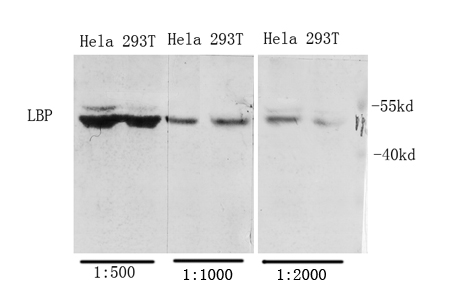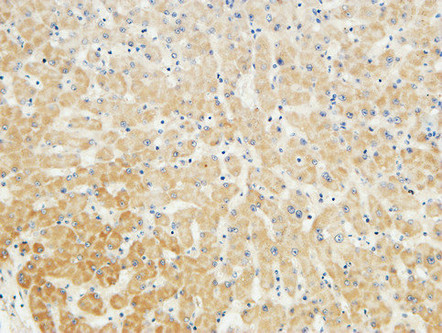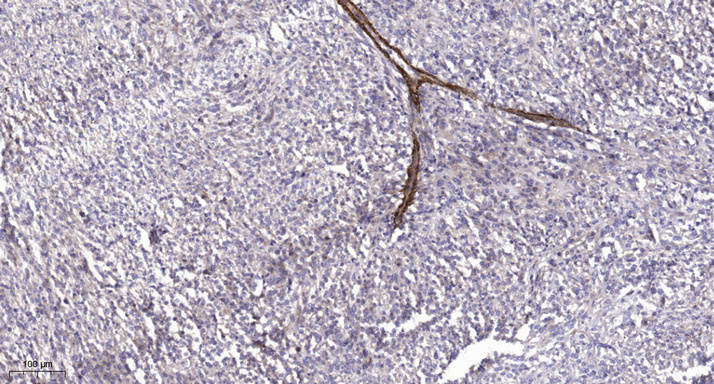LBP Polyclonal Antibody
- Catalog No.:YT2544
- Applications:WB;ELISA;IHC
- Reactivity:Human;Mouse;Rat
- Target:
- LBP
- Fields:
- >>NF-kappa B signaling pathway;>>Toll-like receptor signaling pathway;>>Alcoholic liver disease;>>Tuberculosis;>>Lipid and atherosclerosis
- Gene Name:
- LBP
- Protein Name:
- Lipopolysaccharide-binding protein
- Human Gene Id:
- 3929
- Human Swiss Prot No:
- P18428
- Mouse Gene Id:
- 16803
- Mouse Swiss Prot No:
- Q61805
- Rat Swiss Prot No:
- Q63313
- Immunogen:
- The antiserum was produced against synthesized peptide derived from human LBP. AA range:221-270
- Specificity:
- LBP Polyclonal Antibody detects endogenous levels of LBP protein.
- Formulation:
- Liquid in PBS containing 50% glycerol, 0.5% BSA and 0.02% sodium azide.
- Source:
- Polyclonal, Rabbit,IgG
- Dilution:
- WB 1:500-2000;IHC 1:50-300; ELISA 2000-20000
- Purification:
- The antibody was affinity-purified from rabbit antiserum by affinity-chromatography using epitope-specific immunogen.
- Concentration:
- 1 mg/ml
- Storage Stability:
- -15°C to -25°C/1 year(Do not lower than -25°C)
- Other Name:
- LBP;Lipopolysaccharide-binding protein;LBP
- Observed Band(KD):
- 53kD
- Background:
- lipopolysaccharide binding protein(LBP) Homo sapiens The protein encoded by this gene is involved in the acute-phase immunologic response to gram-negative bacterial infections. Gram-negative bacteria contain a glycolipid, lipopolysaccharide (LPS), on their outer cell wall. Together with bactericidal permeability-increasing protein (BPI), the encoded protein binds LPS and interacts with the CD14 receptor, probably playing a role in regulating LPS-dependent monocyte responses. Studies in mice suggest that the encoded protein is necessary for the rapid acute-phase response to LPS but not for the clearance of LPS from circulation. This protein is part of a family of structurally and functionally related proteins, including BPI, plasma cholesteryl ester transfer protein (CETP), and phospholipid transfer protein (PLTP). [provided by RefSeq, Apr 2012],
- Function:
- function:Binds to the lipid A moiety of bacterial lipopolysaccharides (LPS), a glycolipid present in the outer membrane of all Gram-negative bacteria. The LBP/LPS complex seems to interact with the CD14 receptor.,similarity:Belongs to the BPI/LBP/Plunc superfamily. BPI/LBP family.,
- Subcellular Location:
- Secreted . Cytoplasmic granule membrane . Membrane-associated in polymorphonuclear Leukocytes (PMN) granules. .
- Expression:
- Detected in blood serum (at protein level).
Comprehensive serum proteomics profiles and potential protein biomarkers for the early detection of advanced adenoma and colorectal cancer World Journal of Gastrointestinal Oncology Chang Tan IHC Human 1:50 colon tissue, advanced adenoma (AA) tissue,colorectal cancer (CRC) tissue
- June 19-2018
- WESTERN IMMUNOBLOTTING PROTOCOL
- June 19-2018
- IMMUNOHISTOCHEMISTRY-PARAFFIN PROTOCOL
- June 19-2018
- IMMUNOFLUORESCENCE PROTOCOL
- September 08-2020
- FLOW-CYTOMEYRT-PROTOCOL
- May 20-2022
- Cell-Based ELISA│解您多样本WB检测之困扰
- July 13-2018
- CELL-BASED-ELISA-PROTOCOL-FOR-ACETYL-PROTEIN
- July 13-2018
- CELL-BASED-ELISA-PROTOCOL-FOR-PHOSPHO-PROTEIN
- July 13-2018
- Antibody-FAQs
- Products Images

- Western Blot analysis of various cells using Antibody diluted at 1:1000. Secondary antibody(catalog#:RS0002) was diluted at 1:20000 cells nucleus extracted by Minute TM Cytoplasmic and Nuclear Fractionation kit (SC-003,Inventbiotech,MN,USA).

- Immunohistochemical analysis of paraffin-embedded Human liver. 1, Antibody was diluted at 1:100(4° overnight). 2, High-pressure and temperature EDTA, pH8.0 was used for antigen retrieval. 3,Secondary antibody was diluted at 1:200(room temperature, 30min).

- Immunohistochemical analysis of paraffin-embedded human Colon cancer. 1, Antibody was diluted at 1:200(4° overnight). 2, Tris-EDTA,pH9.0 was used for antigen retrieval. 3,Secondary antibody was diluted at 1:200(room temperature, 45min).



